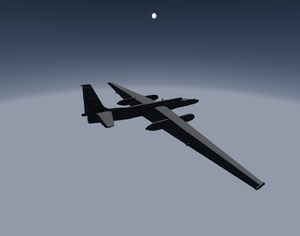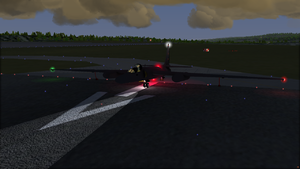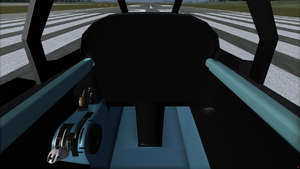Lockheed U-2S: Difference between revisions
No edit summary |
(Usage of the {{tip}} template.) |
||
| (12 intermediate revisions by 6 users not shown) | |||
| Line 1: | Line 1: | ||
{{ | {{distinguish|Lockheed U-2}} | ||
{{tip|The version described in this article is '''''not''''' the one from the official download page / [[FGAddon]] repository. | |||
The version described here can be obtained from my GitHub repository: https://github.com/rebootl/U-2S-git/releases}} | |||
{{:{{PAGENAME}}/info}} | |||
}} | |||
The famous U-2 spyplane, for FlightGear. | The famous U-2 spyplane, for FlightGear. | ||
The | The FlightGear aircraft described here features the latest, modern variant of the U-2, the U-2S. | ||
Currently (2015-10-17) it must still be considered unfinished. | |||
The | The aim of this project is to create a detailed, realistic, but also fun simulation. | ||
Therefore things like e.g. the FDM are developped with great care. The downside to this is that progress is slow. | |||
== Aircraft help == | |||
[[File:U-2S-ext-lights.png|thumb|U-2S, exterior view w/ Rembrandt lights.]] | |||
The simulation starts with the engine off, the aircraft is fueled to about 2/3 capacity. The APU can be thought as connected and the electrics powered on. Currently there is no custom electrical system. External lights are on. | |||
Landing the U-2 is a | === Engine start === | ||
A simplified startup sequence is provided. | |||
* Press and hold "s". This is thought to simulate the APU powering on. | |||
* After about 5 seconds, when 5% of n1 are reached, put the throttle to idle. By pressing } or middle mouse click on the throttle. | |||
* The engine will increase to 60% of n2 and then start. Release "s". | |||
The engine can be started by windmilling, when there is enough altitude to bring the engine to the needed n values. Use above procedure but without pressing "s". This is not (yet) a customized system but the default JSBSim behaviour. | |||
=== Takeoff === | |||
* Close the canopy (Shift-c) and release the parking brake. | |||
* Throttle to full. | |||
* After a short time the pogos will fall off, keep the wings level. | |||
* At about 80 kt the tail will start to rise. Try to keep the two point position. | |||
=== Climb === | |||
* Try to keep 160 kt up to 50,000 ft by adjusting pitch. | |||
* Between 50,000 and 70,000 ft decrease the speed gradually to 105 kt. | |||
=== Descent === | |||
* Throttle to idle. | |||
* Extend the speedbrake (Ctrl-b) and lower the gear. | |||
* Descent with speeds from 105 to 160 kt. | |||
* Below 50,000 ft speed may be increased up to 220 kt. | |||
=== Landing === | |||
* Full flaps. | |||
* Throttle as needed. | |||
* Threshold should be passed 10 ft above ground. | |||
* Touchdown should be made on main and tail gear together. To do this the aircraft is stalled at 1 ft above ground. At this point the main and tail gear should be aligned to the flight direction. | |||
* Try to keep the wings level as long as possible. | |||
* At 60 kt brakes can be applied gently and at 30 kt fully. (Currently the braking force is reduced in the FDM to provide a better handling with a button controller.) | |||
* You can restore the pogos by pressing Shift-r (appropriately when the aircraft has stopped completely). | |||
Have fun! | |||
== Development status == | |||
=== Resources === | |||
Due to the lack of available data I'm using the flight manual of the original U-2. (See external links below.) I'm aware that this is somewhat a different aircraft but I believe it's still a valuable resource. Below I will use "FM" referring to it. Further I'm using images, drawings and flight reports. | |||
=== JSBSim FDM === | |||
Based on a model created using aeromatic: | |||
==== General ==== | |||
* adapted metrics, gears and structural positions, tanks, payload (stub) and gear control | |||
* added custom throttle and fuel system | |||
Open: | |||
* cleanup is really needed, though currently I'm leaving things in as hints for further development | |||
==== Aerodynamics ==== | |||
* polars generated for the main wing (and the hstab) using XFOIL and extended it by Javafoil and commonsense | |||
Open: | |||
* the [[DATCOM]] stuff needs to be redone w/ the information gained (from XFOIL and in general) | |||
* further tuning of flight characteristics acc. to FM | |||
Currently I'm using a "special" configuration that includes the horizontal tail for the pitching moment. Though I'm not convinced that this is best, so it might be subject to change. | |||
==== Fuel system ==== | |||
A JSBSim fuel system is modelled. Only missing is the tank pressurization. | |||
The fuel cross-transfer and dump system is fully functional but since the cockpit isn't finished there are no controls yet. | |||
The respective properties are under /controls/fuel. | |||
(For detailed information see Systems/fuel.xml.) | |||
Estimations were made for the tank capacities. | |||
==== Engine (GE-F118-101) ==== | |||
* changed tsfc | |||
* manually extended the tables to higher altitudes | |||
* bypassratio 2.0 <ref>Only found one source for this by now: http://wiki.scramble.nl/index.php/General_Electric_F101)</ref> | |||
* corrected milthrust to 17,000.0 lb | |||
(See Engine/GE-F118-101.xml.) | |||
=== Model === | |||
==== Exterior ==== | |||
* complete model w/ animated control surfaces, gear and textures | |||
* added lights (supporting Rembrandt, evtl. some finetuning needed) | |||
Open: | |||
* correct the tail gear steering animation | |||
* the texturing and UV-mapping should be reworked (to simplify livery generation) | |||
* add more details (to the gears, inside of the gear-/speedbrake box) | |||
* evtl. correct some positions (e.g. speedbrake) | |||
* evtl. create a normal map | |||
* evtl. add selectable configurations (nose, senior span/spear) | |||
* livery support, add more liveries (e.g. NASA ER-2) | |||
==== Cockpit ==== | |||
[[File:U-2S-cockpit-wip.png|thumb|U-2S cockpit, current development state.]] | |||
Currently I'm working on this. (See the image on the right.) | |||
* reworked the interior w/o instruments | |||
* added throttle and gearbox | |||
Open: | |||
* add instruments/controls (evtl. using the canvas system) | |||
* texturing/UV-mapping | |||
* add more details to the interior | |||
=== Sound === | |||
The sound is taken from FG base package for now. | |||
(Reworked 2013-12-17, see Sounds/U-2S-sounds.xml.) | |||
=== Issues === | |||
* Currently there seems to be a bug in the ejection seat that prevents the pilot loading. | |||
== References == | |||
<references /> | |||
== External links == | |||
* [[:wikipedia:Lockheed U-2|Lockheed U-2]] English wikipedia article. | |||
* https://www.cia.gov/library/center-for-the-study-of-intelligence/utility-flight-hb-1-Mar-1959.pdf The Flight Manual of the original U-2. | |||
* http://www.clubhyper.com/reference/u2sdwa_1.htm Excellent closeup photo reference, intended for aircraft modellers. | |||
* http://www.barryschiff.com/high_flight.htm A flight report. | |||
* http://www.youtube.com/watch?v=1PmYItnlY5M James May in a U-2... | |||
{{Lockheed}} | |||
Latest revision as of 09:00, 27 July 2016
| Tip The version described in this article is not the one from the official download page / FGAddon repository.
The version described here can be obtained from my GitHub repository: https://github.com/rebootl/U-2S-git/releases |
 | |
| Type | Ultra-high altitude aircraft, Reconnaissance aircraft |
|---|---|
| Configuration | Bicycle landing gear aircraft |
| Propulsion | Jet aircraft, Single-engine aircraft |
| Manufacturer | Lockheed |
| Author(s) | Cem Aydin |
| FDM | JSBSim |
| --aircraft= | U-2S |
| Status | Alpha |
| FDM |
|
| Systems |
|
| Cockpit |
|
| Model |
|
| Download |
|
|
| |
The famous U-2 spyplane, for FlightGear.
The FlightGear aircraft described here features the latest, modern variant of the U-2, the U-2S.
Currently (2015-10-17) it must still be considered unfinished.
The aim of this project is to create a detailed, realistic, but also fun simulation.
Therefore things like e.g. the FDM are developped with great care. The downside to this is that progress is slow.
Aircraft help
The simulation starts with the engine off, the aircraft is fueled to about 2/3 capacity. The APU can be thought as connected and the electrics powered on. Currently there is no custom electrical system. External lights are on.
Engine start
A simplified startup sequence is provided.
- Press and hold "s". This is thought to simulate the APU powering on.
- After about 5 seconds, when 5% of n1 are reached, put the throttle to idle. By pressing } or middle mouse click on the throttle.
- The engine will increase to 60% of n2 and then start. Release "s".
The engine can be started by windmilling, when there is enough altitude to bring the engine to the needed n values. Use above procedure but without pressing "s". This is not (yet) a customized system but the default JSBSim behaviour.
Takeoff
- Close the canopy (Shift-c) and release the parking brake.
- Throttle to full.
- After a short time the pogos will fall off, keep the wings level.
- At about 80 kt the tail will start to rise. Try to keep the two point position.
Climb
- Try to keep 160 kt up to 50,000 ft by adjusting pitch.
- Between 50,000 and 70,000 ft decrease the speed gradually to 105 kt.
Descent
- Throttle to idle.
- Extend the speedbrake (Ctrl-b) and lower the gear.
- Descent with speeds from 105 to 160 kt.
- Below 50,000 ft speed may be increased up to 220 kt.
Landing
- Full flaps.
- Throttle as needed.
- Threshold should be passed 10 ft above ground.
- Touchdown should be made on main and tail gear together. To do this the aircraft is stalled at 1 ft above ground. At this point the main and tail gear should be aligned to the flight direction.
- Try to keep the wings level as long as possible.
- At 60 kt brakes can be applied gently and at 30 kt fully. (Currently the braking force is reduced in the FDM to provide a better handling with a button controller.)
- You can restore the pogos by pressing Shift-r (appropriately when the aircraft has stopped completely).
Have fun!
Development status
Resources
Due to the lack of available data I'm using the flight manual of the original U-2. (See external links below.) I'm aware that this is somewhat a different aircraft but I believe it's still a valuable resource. Below I will use "FM" referring to it. Further I'm using images, drawings and flight reports.
JSBSim FDM
Based on a model created using aeromatic:
General
- adapted metrics, gears and structural positions, tanks, payload (stub) and gear control
- added custom throttle and fuel system
Open:
- cleanup is really needed, though currently I'm leaving things in as hints for further development
Aerodynamics
- polars generated for the main wing (and the hstab) using XFOIL and extended it by Javafoil and commonsense
Open:
- the DATCOM stuff needs to be redone w/ the information gained (from XFOIL and in general)
- further tuning of flight characteristics acc. to FM
Currently I'm using a "special" configuration that includes the horizontal tail for the pitching moment. Though I'm not convinced that this is best, so it might be subject to change.
Fuel system
A JSBSim fuel system is modelled. Only missing is the tank pressurization.
The fuel cross-transfer and dump system is fully functional but since the cockpit isn't finished there are no controls yet.
The respective properties are under /controls/fuel.
(For detailed information see Systems/fuel.xml.)
Estimations were made for the tank capacities.
Engine (GE-F118-101)
- changed tsfc
- manually extended the tables to higher altitudes
- bypassratio 2.0 [1]
- corrected milthrust to 17,000.0 lb
(See Engine/GE-F118-101.xml.)
Model
Exterior
- complete model w/ animated control surfaces, gear and textures
- added lights (supporting Rembrandt, evtl. some finetuning needed)
Open:
- correct the tail gear steering animation
- the texturing and UV-mapping should be reworked (to simplify livery generation)
- add more details (to the gears, inside of the gear-/speedbrake box)
- evtl. correct some positions (e.g. speedbrake)
- evtl. create a normal map
- evtl. add selectable configurations (nose, senior span/spear)
- livery support, add more liveries (e.g. NASA ER-2)
Cockpit
Currently I'm working on this. (See the image on the right.)
- reworked the interior w/o instruments
- added throttle and gearbox
Open:
- add instruments/controls (evtl. using the canvas system)
- texturing/UV-mapping
- add more details to the interior
Sound
The sound is taken from FG base package for now.
(Reworked 2013-12-17, see Sounds/U-2S-sounds.xml.)
Issues
- Currently there seems to be a bug in the ejection seat that prevents the pilot loading.
References
- ↑ Only found one source for this by now: http://wiki.scramble.nl/index.php/General_Electric_F101)
External links
- Lockheed U-2 English wikipedia article.
- https://www.cia.gov/library/center-for-the-study-of-intelligence/utility-flight-hb-1-Mar-1959.pdf The Flight Manual of the original U-2.
- http://www.clubhyper.com/reference/u2sdwa_1.htm Excellent closeup photo reference, intended for aircraft modellers.
- http://www.barryschiff.com/high_flight.htm A flight report.
- http://www.youtube.com/watch?v=1PmYItnlY5M James May in a U-2...
| ||||||||

